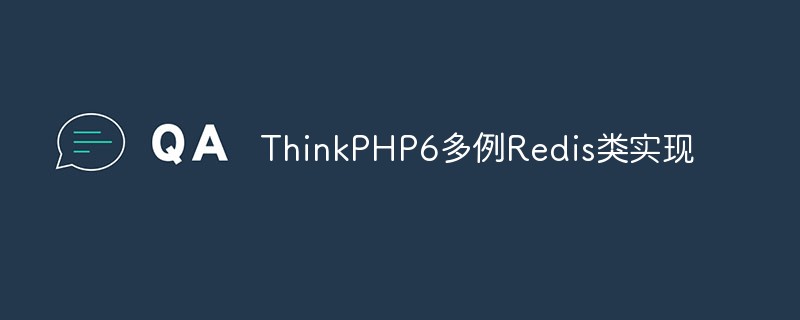關於ThinkPHP6多例Redis類別實現
以下由thinkphp教學專欄跟大家介紹ThinkPHP6多例Redis類別實現,希望對需要的朋友有幫助!

#在Thinkphp專案中封裝一個Redis多庫單例操作類別
1.操作前的準備
#如果沒有安裝phpredis模組那麼先執行
composer require predis/predis
2.設定Redis連線資訊
在app\config\cache.php中設定
'redis' => [
// 驱动方式
'type' => 'redis',
// 连接地址
'host' => Env::get('redis.host'),
// 端口
'port' => Env::get('redis.port'),],更多設定參考
/**
* 配置参数
* @var array
*/protected $options = [
'host' => '127.0.0.1',
'port' => 6379,
'password' => '',
'select' => 0,
'timeout' => 0,
'expire' => 0,
'persistent' => false,
'prefix' => '',
'tag_prefix' => 'tag:',
'serialize' => [],];在.env中設定連線訊息
[REDIS]host = 127.0.0.1 port = 6379
3.編寫程式碼
在app\common下建立檔案Redis.php
<?phpnamespace app\common;use think\facade\Config;use think\cache\driver\redis as ThinkRedis;class Redis extends ThinkRedis{
/**
* @var int
*/
protected $hash;
/**
* @var array
*/
protected static $instance = [];
/**
* Redis constructor.
* @param $db
*/
private function __construct($db)
{
$options = Config::get('cache.stores.redis');
$options['select'] = $db;
$this->hash = $db;
$this->options = array_merge($this->options, $options);
parent::__construct();
}
private function __clone()
{
}
/**
* @param int $db
* @return \Predis\Client|\Redis
*/
public static function instance($db = 0)
{
if (! isset(self::$instance[$db])) {
self::$instance[$db] = new self($db);
}
return self::$instance[$db];
}
public function __destruct()
{
self::$instance[$this->hash]->close();
unset(self::$instance[$this->hash]);
}}4.使用方式
use app\common\Redis; $redis = Redis::instance(4); $redis->hSet('user:1', 'userName', 'admin'); Redis::instance(1)->hSet('user', 'name', 'admin1'); Redis::instance(2)->hSet('user', 'name', 'admin2'); Redis::instance(3)->hSet('user', 'name', 'admin3');
更多使用方法請參考redis指令手冊
#以上是關於ThinkPHP6多例Redis類別實現的詳細內容。更多資訊請關注PHP中文網其他相關文章!

熱AI工具

Undresser.AI Undress
人工智慧驅動的應用程序,用於創建逼真的裸體照片

AI Clothes Remover
用於從照片中去除衣服的線上人工智慧工具。

Undress AI Tool
免費脫衣圖片

Clothoff.io
AI脫衣器

Video Face Swap
使用我們完全免費的人工智慧換臉工具,輕鬆在任何影片中換臉!

熱門文章

熱工具

記事本++7.3.1
好用且免費的程式碼編輯器

SublimeText3漢化版
中文版,非常好用

禪工作室 13.0.1
強大的PHP整合開發環境

Dreamweaver CS6
視覺化網頁開發工具

SublimeText3 Mac版
神級程式碼編輯軟體(SublimeText3)
 redis集群模式怎麼搭建
Apr 10, 2025 pm 10:15 PM
redis集群模式怎麼搭建
Apr 10, 2025 pm 10:15 PM
Redis集群模式通過分片將Redis實例部署到多個服務器,提高可擴展性和可用性。搭建步驟如下:創建奇數個Redis實例,端口不同;創建3個sentinel實例,監控Redis實例並進行故障轉移;配置sentinel配置文件,添加監控Redis實例信息和故障轉移設置;配置Redis實例配置文件,啟用集群模式並指定集群信息文件路徑;創建nodes.conf文件,包含各Redis實例的信息;啟動集群,執行create命令創建集群並指定副本數量;登錄集群執行CLUSTER INFO命令驗證集群狀態;使
 redis數據怎麼清空
Apr 10, 2025 pm 10:06 PM
redis數據怎麼清空
Apr 10, 2025 pm 10:06 PM
如何清空 Redis 數據:使用 FLUSHALL 命令清除所有鍵值。使用 FLUSHDB 命令清除當前選定數據庫的鍵值。使用 SELECT 切換數據庫,再使用 FLUSHDB 清除多個數據庫。使用 DEL 命令刪除特定鍵。使用 redis-cli 工具清空數據。
 redis怎麼讀取隊列
Apr 10, 2025 pm 10:12 PM
redis怎麼讀取隊列
Apr 10, 2025 pm 10:12 PM
要從 Redis 讀取隊列,需要獲取隊列名稱、使用 LPOP 命令讀取元素,並處理空隊列。具體步驟如下:獲取隊列名稱:以 "queue:" 前綴命名,如 "queue:my-queue"。使用 LPOP 命令:從隊列頭部彈出元素並返回其值,如 LPOP queue:my-queue。處理空隊列:如果隊列為空,LPOP 返回 nil,可先檢查隊列是否存在再讀取元素。
 centos redis如何配置Lua腳本執行時間
Apr 14, 2025 pm 02:12 PM
centos redis如何配置Lua腳本執行時間
Apr 14, 2025 pm 02:12 PM
在CentOS系統上,您可以通過修改Redis配置文件或使用Redis命令來限制Lua腳本的執行時間,從而防止惡意腳本佔用過多資源。方法一:修改Redis配置文件定位Redis配置文件:Redis配置文件通常位於/etc/redis/redis.conf。編輯配置文件:使用文本編輯器(例如vi或nano)打開配置文件:sudovi/etc/redis/redis.conf設置Lua腳本執行時間限制:在配置文件中添加或修改以下行,設置Lua腳本的最大執行時間(單位:毫秒)
 redis指令怎麼用
Apr 10, 2025 pm 08:45 PM
redis指令怎麼用
Apr 10, 2025 pm 08:45 PM
使用 Redis 指令需要以下步驟:打開 Redis 客戶端。輸入指令(動詞 鍵 值)。提供所需參數(因指令而異)。按 Enter 執行指令。 Redis 返迴響應,指示操作結果(通常為 OK 或 -ERR)。
 redis怎麼使用鎖
Apr 10, 2025 pm 08:39 PM
redis怎麼使用鎖
Apr 10, 2025 pm 08:39 PM
使用Redis進行鎖操作需要通過SETNX命令獲取鎖,然後使用EXPIRE命令設置過期時間。具體步驟為:(1) 使用SETNX命令嘗試設置一個鍵值對;(2) 使用EXPIRE命令為鎖設置過期時間;(3) 當不再需要鎖時,使用DEL命令刪除該鎖。
 redis命令行怎麼用
Apr 10, 2025 pm 10:18 PM
redis命令行怎麼用
Apr 10, 2025 pm 10:18 PM
使用 Redis 命令行工具 (redis-cli) 可通過以下步驟管理和操作 Redis:連接到服務器,指定地址和端口。使用命令名稱和參數向服務器發送命令。使用 HELP 命令查看特定命令的幫助信息。使用 QUIT 命令退出命令行工具。
 redis過期策略怎麼設置
Apr 10, 2025 pm 10:03 PM
redis過期策略怎麼設置
Apr 10, 2025 pm 10:03 PM
Redis數據過期策略有兩種:定期刪除:定期掃描刪除過期鍵,可通過 expired-time-cap-remove-count、expired-time-cap-remove-delay 參數設置。惰性刪除:僅在讀取或寫入鍵時檢查刪除過期鍵,可通過 lazyfree-lazy-eviction、lazyfree-lazy-expire、lazyfree-lazy-user-del 參數設置。






